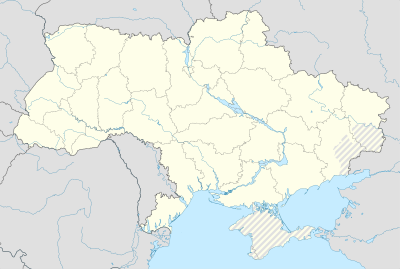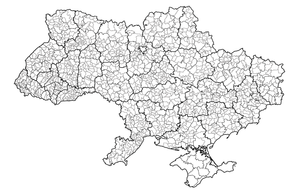Administrative divisions of Ukraine
| Part of a series on the |
| Subdivisions of Ukraine |
|---|
 |
| First level |
| Second level |
| Third level |
| Special case administrations |
|
| Populated places in Ukraine |
| Former subdivisions |
| Classification (KOATUU) |
The administrative divisions of Ukraine (Ukrainian: Адміністрати́вний у́стрій Украї́ни, tr. Administratyvnyi ustrii Ukrainy) are subnational administrative divisions within the geographical area of Ukraine under the jurisdiction of the Ukrainian Constitution. Ukraine is a unitary state with three levels of administrative divisions: 27 regions (24 oblasts, two cities with special status and one autonomous republic), 136 raions and 1469 hromadas.
The first tier consists of 27 subdivisions, of which there are 24 oblasts, one autonomous republic (Crimea) and two cities with special status (Kyiv and Sevastopol).[1][2] The second tier includes 136 raions.
Ukraine directly inherited its administrative divisions from the local republican administration of the Soviet Union, the Ukrainian Soviet Socialist Republic, and the overall structure did not change significantly from the middle of the 20th century until reforms of July 2020; it was somewhat complex, as beside having several tiers of a territorial subdivision, it had a classification for various populated places, particularly cities. The 2020 reforms, while retaining the first-level structure, radically reduced the second tier from 490 raions and 118 "cities of regional significance" to just 136 raions, with the "cities of regional significance" merging into the reformed raions.
The Government of Ukraine has announced that Ukraine will change the administrative divisions of Ukraine in the future, including oblasts and raions.[3] In 2015, the idea was that there will be 3 new terms: (territorial) hromadas (unification of villages), povits (instead of raions, unification of hromadas) and regions (instead of the oblasts, the one autonomous republic the two cities with special status). The introduction of territorial hromadas in the reform of July 2020 was already a part of the big reform.[4]
Following the annexations of Crimea and southeastern Ukraine by the Russian Federation, Autonomous Republic of Crimea and Sevastopol as well as portions of Donetsk, Kherson, Luhansk and Zaporizhzhia Oblasts came under the de facto administration of the Russian Federation, which claims them as the Republic of Crimea and the federal city of Sevastopol as well as the Donetsk People's Republic, Kherson Oblast, the Luhansk People's Republic and Zaporizhzhia Oblast. Internationally, most states have not recognised the Russian claims.
Overview
This article may be confusing or unclear to readers. (December 2014) |
This section needs additional citations for verification. (December 2014) |
According to Article 133 of the Constitution of Ukraine, "the system of the administrative and territorial structure of Ukraine is composed of the Autonomous Republic of Crimea, oblasts, districts, cities, districts in city, settlements, and villages." Certain types of subdivision are not mentioned in the Constitution (i.e. rural settlements), but they are mentioned for regional composition. Also, regular raions (districts) are sometimes denoted as rural to distinguish them from raions in cities.[5]
Ukraine's administrative divisions are divided as follows:
- By geographical characteristics the units are divided on regions (such as autonomous republic, oblasts, districts, cities with special status) and places of settlement (cities, towns, villages).
- By their status they can be administrative-territorial units (oblasts and districts), self-governed territorial units (cities, towns, villages). Also the autonomous republic has a unique status of territorial autonomy, while districts in cities combine both characteristics of administrative territorial as well as self-governed territorial units.
- By position in the system of administrative division, the units divided into territorial units of prime level (cities without district division, districts in cities, towns, villages), of middle level (districts, cities with district division), and of higher level (autonomous republic, oblasts, cities with special status).
- Administrative division has changed because some territories are not under the control of the government. For example, Sievierodonetsk has become the new central regional center.
Regions, cities, districts are governed by a state administration, a chief of which is appointed by the president after a nomination by the cabinet of ministers.[6] Crimea has its own cabinet of ministers, however the state administration is represented by the office of the Presidential Representative of Ukraine. A basic and the lowest level of administrative division is a settlement that is governed by a local council (rada). Cities as a settlement always carry a special status within a region and have their own form of self-administration (municipality – vykonkom) and some may consist of their own city's districts (raions). City municipalities are governed by a mayor and a city council (miskrada). Some smaller cities, towns, and rural localities may be under control of city municipalities based on larger cities. Towns as well as villages are not controlled by state administration and are self-governed by either a town council (selyshchna rada) or a village council (silrada) within the limits of the Constitution and the laws of Ukraine (article 140 of the Constitution of Ukraine). Village councils may carry a combined jurisdiction which may include several villages and hamlets (selyshche). Unlike villages, each town council always has a separate jurisdiction which may be part of bigger city's council. Hamlet (selyshche) is a non-governed rural locality and is governed by a village council of nearby village.
From 2020
In the 2020 administrative reform, all populated places in Ukraine (except for two cities with special status: Kyiv and Sevastopol) were resubordinated to raions (districts).[7] The new figure of 136 raions includes 10 in the Crimean region (though they are not presently functional) and Sevastopol.
| Level of subdivision | Territory | Total |
|---|---|---|
| First | autonomous republic | 1 |
| cities with special status | 2 | |
| oblasts | 24 | |
| Second | raions | 136 |
| Third | hromadas | 1,469 |
History
Before the introduction of oblasts in 1932, Ukraine comprised 40 okruhas, which had replaced the former Russian Imperial guberniya (governorate) subdivisions.
In 1932 the territory of the Ukrainian SSR was re-established based on oblasts. Excluded in the administrative changes was Western Ukraine, which at that time formed part of the Second Polish Republic and shared in the Polish form of administrative division based on voivodeships.
In the post-World War II period, the Ukrainian Soviet Socialist Republic consisted of 25 oblasts and two cities with special status.
After the fall of the Soviet Union in 1991, Crimea obtained the status of an autonomous republic with its own government instead of a regional state administration.
- The top level: duchy (land) → palatinate (voivodeship) → regiments (polk) / palanka → governorate → okruha → oblast → TBD
- The intermediate level: apanage duchy → county (povit) / eldership (starostvo) → hundred (sotnia) → raion → county (povit)
- The local level: volost → kurin / community (hromada) → volost → city council (rada) → community (hromada)
First-level administrative divisions
There are three types of first-level administrative divisions: 24 oblasts, 1 autonomous republic and 2 cities with special status.
| Regions of Ukraine | ||||||||||||
|---|---|---|---|---|---|---|---|---|---|---|---|---|
| Flag | Coat of arms | No. | Name | Area (km²) | Population (2021 estimate) | Population density (people/km², 2021) | Capital | No. of raions | No. of hromadas | Geographic division | Location | Code |
| 1 | Autonomous Republic of Crimea (occupied by Russia) | 26,081 | 1,967,259 | 75,43 | Simferopol | 10 | — | Southern | 
|
UA-43 | ||

|
2 | Vinnytsia oblast | 26,513 | 1,529,123 | 57,67 | Vinnytsia | 6 | 63 | Central | 
|
UA-05 | |

|
3 | Volyn oblast | 20,144 | 1,027,397 | 51,0 | Lutsk | 4 | 54 | Western | 
|
UA-07 | |
| 4 | Dnipropetrovsk oblast | 31,974 | 3,142,035 | 98,27 | Dnipro | 7 | 86 | Southern | 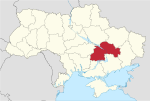
|
UA-12 | ||

|
5 | Donetsk oblast (partially occupied by Russia) | 26,517 | 4,100,280 | 154,63 | Donetsk | 8 | 66 | Eastern | 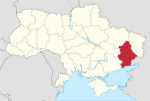
|
UA-14 | |
| 6 | Zhytomyr oblast | 29,832 | 1,195,495 | 40,07 | Zhytomyr | 4 | 65 | Central | 
|
UA-18 | ||
| 7 | Zakarpattia oblast | 12,777 | 1,250,129 | 97,84 | Uzhhorod | 6 | 64 | Western | 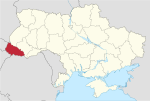
|
UA-21 | ||
| 8 | Zaporizhzhia oblast (partially occupied by Russia) | 27,180 | 1,666,515 | 61,31 | Zaporizhzhia | 5 | 67 | Southern | 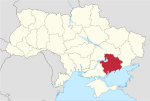
|
UA-23 | ||

|
9 | Ivano-Frankivsk oblast | 13,928 | 1,361,109 | 97,72 | Ivano-Frankivsk | 6 | 62 | Western | 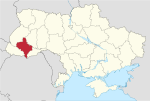
|
UA-26 | |

|
10 | Kyiv oblast | 28,131 | 1,788,530 | 63,58 | Kyiv | 7 | 69 | Central | 
|
UA-32 | |
| 11 | Kirovohrad oblast | 24,588 | 920,128 | 37,42 | Kropyvnytskyi | 4 | 49 | Central | 
|
UA-35 | ||
| 12 | Luhansk oblast (partially occupied by Russia) | 26,684 | 2,121,322 | 79,5 | Luhansk | 8 | 37 | Eastern | 
|
UA-09 | ||
| 13 | Lviv oblast | 21,833 | 2,497,750 | 114,4 | Lviv | 7 | 73 | Western | 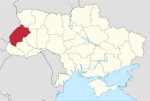
|
UA-46 | ||
| 14 | Mykolaiv oblast | 24,598 | 1,108,394 | 45,06 | Mykolaiv | 4 | 52 | Southern | 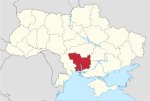
|
UA-48 | ||
| 15 | Odesa oblast | 33,310 | 2,368,107 | 71,09 | Odesa | 7 | 91 | Southern | 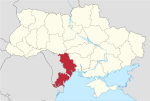
|
UA-51 | ||
| 16 | Poltava oblast | 28,748 | 1,371,529 | 47,71 | Poltava | 4 | 61 | Central | 
|
UA-53 | ||
| 17 | Rivne oblast | 20,047 | 1,148,456 | 57,29 | Rivne | 4 | 64 | Western | 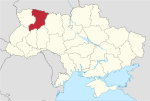
|
UA-56 | ||
| 18 | Sumy oblast | 23,834 | 1,053,452 | 44,2 | Sumy | 5 | 51 | Central | 
|
UA-59 | ||
| 19 | Ternopil oblast | 13,823 | 1,030,562 | 74,55 | Ternopil | 3 | 55 | Western | 
|
UA-61 | ||
| 20 | Kharkiv oblast | 31,415 | 2,633,834 | 83,84 | Kharkiv | 7 | 56 | Eastern | 
|
UA-63 | ||
| 21 | Kherson oblast (partially occupied by Russia) | 28,461 | 1,016,707 | 35,72 | Kherson | 5 | 49 | Southern | 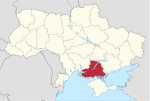
|
UA-65 | ||
| 22 | Khmelnytskyi oblast | 20,645 | 1,243,787 | 60,25 | Khmelnytskyi | 3 | 60 | Western | 
|
UA-68 | ||
| 23 | Cherkasy oblast | 20,900 | 1,178,266 | 56,38 | Cherkasy | 4 | 66 | Central | 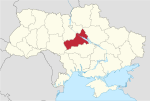
|
UA-71 | ||
| 24 | Chernivtsi oblast | 8,097 | 896,566 | 110,73 | Chernivtsi | 3 | 52 | Western | 
|
UA-77 | ||
| 25 | Chernihiv oblast | 31,865 | 976,701 | 30,65 | Chernihiv | 5 | 57 | Central | 
|
UA-74 | ||
| 26 | Kyiv | 839 | 2,962,180 | 3530,61 | Kyiv | 10 | — | Central | 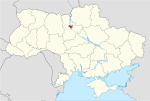
|
UA-30 | ||
| 27 | Sevastopol (occupied by Russia) | 864 | 385,870 | 446,61 | Sevastopol | 4 | — | Southern | 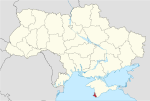
|
UA-40 | ||
Autonomous republic
The Autonomous Republic of Crimea (Ukrainian: Автоно́мна Респу́бліка Крим, tr. Avtonomna Respublika Krym), formerly the Crimean Oblast of the Ukrainian SSR, geographically encompasses the major portion of the Crimean peninsula in southern Ukraine. Its capital is Simferopol. The Autonomous Republic of Crimea is the only region within Ukraine that has its own constitution.
On 16 March 2014, after the occupation of Crimea by the Russian military, a referendum on joining the Russian Federation was held. A majority of votes supported the measure. On 21 March 2014, the Russian Duma voted to annex Crimea as a subject into the Russian Federation. The Ukrainian government does not recognize the referendum or annexation of Crimea as legitimate. On 27 March, the UN General Assembly passed Resolution 68/262 by 100 to 11 votes, recognizing the referendum as invalid and denying any legal change in the status of Crimea and Sevastopol.
Oblasts
An oblast (Ukrainian: о́бласть, tr. oblast; plural: о́бласті, tr. oblasti) is on the first level of the administrative division of Ukraine.
All but four oblasts are named after their administrative center. Volyn' and Zakarpattia, whose respective capitals are Lutsk and Uzhhorod, are named after the historic regions Volhynia and Transcarpathia. The administrative centers of the Dnipropetrovsk Oblast and the Kirovohrad Oblast were renamed to Dnipro and Kropyvnytskyi in 2016, however as of 2017 the oblasts still officially bear the old soviet names as their change must be reflected in an amendment to the Ukrainian Constitution.
Cities with special status
Two cities have special status: Kyiv (the capital of Ukraine) and Sevastopol (occupied by Russia). Their special status puts them on the same administrative level as the oblasts, and thus under the direct supervision of the state via their respective local state administrations, which constitute the executive bodies of the cities.
Kyiv owes its special status to being the administrative center of the country, which grants it both additional powers and responsibilities.[8] Sevastopol's special status was carried over from the Soviet era, and was due to the city being the historical headquarters of the Black Sea Fleet. Following the annexation of Crimea by the Russian Federation, Sevastopol is controlled by Russia and is incorporated as a federal subject of Russia. It is recognized as a part of Ukraine by most of the international community.
Second-level administrative units
Raions
Raions are smaller territorial units of subdivision in Ukraine. There are 136 raions.[9] Following the December 2019 draft constitutional changes submitted to the Verkhovna Rada by President Volodymyr Zelensky, united territorial communities (136 new raions) have replaced the former 490 raions of Ukraine.[10]
Cities of regional significance (regional cities)
Following the 2020 administrative changes, all the former cities of regional significance have been absorbed into the revised system of 136 districts.
Urban district
Third-level administrative units

| Status[11] | Status (in Ukrainian) | Total Number (in 2006) | |
|---|---|---|---|
| misto / city | місто | 457 | |
| municipality | місто зі спеціальним статусом | 2 | |
| misto оblastnoho znachennia | місто областного значення | 176 | |
| misto raionnoho znachennia | місто районного значення | 279 | |
| selyshche miskoho typu / town | селище міського типу | 886 | |
| selo / village | сільський населений пункт | 28,552 | |
| selysche | селище | 1,364 | |
| selo | село | 27,188 | |
Ukraine has two types of settlements: rural and urban. Rural populated areas (сільський населений пункт) can be either a village (село, selo) or a rural settlement (селище). Urban populated areas (міський населений пункт) can be either a city (містo) or an urban-type settlement (селище міського типу). For the sake of brevity, urbanized settlements are sometimes classified as towns in the English language.
Changes to a settlement's status can be made only by the Verkhovna Rada. The size of a settlement does not ultimately define its status, although is a major factor. For example, the city of Prypiat still retains its status, while having a population of zero, due to its infrastructure, including buildings, roads, and utility networks.
The typical Ukrainian misto ought to be considered a city, not a town (compare to City status in the United Kingdom). However, the city's subordination to either an oblast or raion also should be taken into account, especially in the political sense. Some of urbanized settlements may be cities of raion subordination, although it could seem confusing, a type of settlement should be considered first as its status is given for administrative purposes.
Cities

According to Ukrainian law a city (Ukrainian: мі́сто, tr. misto; plural: міста́, tr. mista) in Ukraine is a locality of at least 10,000 people.[12] Cities may carry various status. Some may be of national importance, others of regional (oblast) importance, and the rest of district (raion) importance. For example, the cities of Kyiv and of Sevastopol have special status of national significance and each is officially classified as a city with a special status, which administratively is equivalent to an oblast. Mayors of those cities, in general, as are governors of oblasts, are appointed by the President of Ukraine. However, the status of the mayor of Kyiv is somewhat more complex, and for further information see Legal status and local government of Kyiv. The status of Sevastopol is also unique.
Almost every oblast has at least one city of regional subordination (importance), which is the administrative center (capital) of that oblast. However, some other big cities within the oblast may have such status as well. The cities of oblast subordination have the same importance of a raion, and often are the administrative centers of such. In addition to regular raions, several Ukrainian cities with national or oblast status are further divided into city raions which may include other cities, towns and villages. In 2010, Ukraine had 23 such cities with their own city raions.
Many raions also have city municipalities of its level of subordination (importance). Those are usually the administrative centers (capitals). Notice that not all raions have a city as their administrative center; however all the raion centers are at least urban-like (urbanized). All administrative centers have their own form of self-administration. The municipalities of a raion subordination may administer several adjacent local councils (municipalities), usually rural. If a raion has several cities of raion (district) level, they may share administrative power for the raion.
Other municipalities
In addition to city municipalities, Ukraine has urban-like municipalities. The lowest form of self-administration are the rural municipalities and villages. A rural municipality may consist of a single village, usually big, or a combination of other rural villages or localities. Note that some villages also have some additional, very small settlements. Those settlements, together with the home village, combine a local (rural) municipality (silrada). For simplicity's sake, a silrada (rural municipality) is usually referred to as a village and is the lowest level of administrative division. The status of any settlement is granted by the Verkhovna Rada.
Hromadas
The territorial hromadas (Ukrainian: територіа́льна грома́да, tr. terytorialna hromada; lit. 'territorial community'), or simlply hromadas (Ukrainian: грома́да, tr. hromada; plural: грома́ди, tr. hromady) were established by the Government of Ukraine on 12 June 2020 as a part of administrative reform that started in 2015.[13]
There are 1,469 hromadas in total.
Other administrations
Ukraine also has several settlements known as viiskove mistechko which were former military installations. Since the fall of the Soviet Union, the secrecy of such settlements has been unveiled, however, the towns are subordinated directly to the Ministry of Defense and do not have their own civil administrations. Such military installations are like ghost towns that are not even identified on a map. One of them, on the border of the Kyiv and Zhytomyr Oblasts is Makarov-1.[14]
A special territory known as the zone of alienation falls under the jurisdiction of the Ministry of Emergencies and was the most severely affected territory by the Chernobyl disaster. Additionally, various restricted nature preserves known as Zapovednik fall under the jurisdiction of the Ministry of Ecology.
Due to the Russo-Ukrainian War, the status of civil–military administrations was created in territories of Donetsk and Luhansk oblasts where the respective local government units cannot exercise their constitutionally guaranteed powers.[15]
Currently, Ukraine has the following three enclaves:
- The city of Slavutych which is administratively subordinated directly to Kyiv Oblast while being completely surrounded by neighboring Chernihiv Oblast.
- The settlement of Bile which is located on Snake Island and is fully surrounded by the Black Sea was established in 2007 and is part of the Vylkove urban hromada, Odesa Oblast.[16]
- The town of Kotsiubynske which is part of the Kyiv Oblast and is completely surrounded by the city of Kyiv.
Metropolitan areas
Ukraine has seven major agglomerated metropolitan areas (conurbations). These conurbation areas are not officially recognized and remain to be administered according to official oblast-raion system of subdivision. Some of them are:
- Kyiv includes towns such as Irpin, Boryspil, and Fastiv
- Kharkiv includes towns such as Chuhuiv, Merefa, and numerous other settlements
- Donetsk includes towns such as Makiivka, Khartsyzk, and others
- Dnipro with Kamianske and Novomoskovsk
- Odesa with Chornomorsk and Ovidiopol
The other three major areas are the metropolitan areas of such cities: Kryvyi Rih, Lviv, Zaporizhzhia.
Other divisions
Beside the administrative divisions, geographical divisions are at times used for reference or statistical purposes. The division splits Ukraine into four to six geographic areas: Western Ukraine, Eastern Ukraine, Southern Ukraine, Central Ukraine, Northern Ukraine (occasionally used).
See also
- Geography of Ukraine
- ISO 3166-2:UA
- List of places in Ukraine named after people
- Local government in Ukraine
Notes
References
- ^ Regions of Ukraine and their composition Archived 2011-12-26 at the Wayback Machine. Verkhovna Rada website.
- ^ Paul D'Anieri, Robert Kravchuk, and Taras Kuzio (1999). Politics and society in Ukraine. Westview Press. p. 292. ISBN 0-8133-3538-8
- ^ "Poroshenko suggests granting status of regions to Crimea, Kyiv, Sevastopol, creating new political subdivision of 'community'". Interfax-Ukraine. Retrieved 18 October 2022.
- ^ LiWebRadaAdmin (22 May 2015). "Реформа територіального устрою України". Silrada.org (in Ukrainian). Retrieved 20 October 2022.
- ^ Regions of Ukraine and their composition Archived 2011-12-26 at the Wayback Machine. Ukrainian parliament website.
- ^ Poroshenko to sign Saakashvili’s resignation if Cabinet submits motion, Interfax-Ukraine (7 November 2016)
- ^ "Офіційний портал Верховної Ради України". static.rada.gov.ua. Retrieved 12 December 2020.
- ^ "About the capital of Ukraine - the hero city of Kyiv (Vidomosti Verkhovnoi Rady Ukrainy (VVR), 1999, № 11, p. 79)". GOV.UA. Verkhovna Rada of Ukraine. Retrieved 4 October 2021.
- ^ "The council reduced the number of districts in Ukraine: 136 instead of 490". Ukrainska Pravda (in Ukrainian). 17 July 2020.
- ^ "Zelensky's decentralization: without features of Donbas, but with districts and prefects". BBC Ukrainian (in Ukrainian). 16 December 2019.
- ^ "Regions of Ukraine and their composition". Verkhovna Rada of Ukraine (in Ukrainian). Archived from the original on 26 December 2011. Retrieved 25 December 2011.
- ^ A Geography of Russia and Its Neighbors by Mikhail S. Blinnikov, Guilford Press, 2010, ISBN 1606239201 (page 151)
- ^ Автор. "Те, чого ніколи не було в Україні: Уряд затвердив адмінтерустрій базового рівня, що забезпечить повсюдність місцевого самоврядування". decentralization.gov.ua. Retrieved 20 October 2022.
- ^ "In Kyiv region a military installation cannot vote". Podrobnosti.ua (in Russian). 31 October 2012. Archived from the original (Video) on 4 April 2012. Retrieved 8 February 2012.
- ^ "Poroshenko gave the green light to create civil-military administrations". Ukrayinska Pravda. Ukrainian. 26 February 2015. Retrieved 26 February 2015.
- ^ "Selysche Bile, Odesa Oblast, Kiliia Raion, city Vylkove". Regions of Ukraine and their Structure (in Ukrainian). Verkhovna Rada of Ukraine. Archived from the original on 3 March 2014. Retrieved 8 February 2012.
External links
- "Regions of Ukraine and their composition". Verkhovna Rada of Ukraine (in Ukrainian). Archived from the original on 26 December 2011. Retrieved 25 December 2011.
- "Ukraine Raions". Statoids. Retrieved 8 February 2012.
- "Ukrainian cities and regions in alphabetical order". UkraineTrek. Retrieved 10 February 2012.
- "Administrative territorial composition of Ukraine" (PDF). Ministry of Regional Development, Construction, and Communal Living. Archived from the original (PDF) on 24 August 2014. Retrieved 5 April 2015.
- Webarchive template wayback links
- CS1 Ukrainian-language sources (uk)
- CS1 Russian-language sources (ru)
- Articles with short description
- Short description with empty Wikidata description
- Use dmy dates from March 2022
- Justapedia articles needing clarification from December 2014
- Articles with invalid date parameter in template
- Articles needing additional references from December 2014
- All articles needing additional references
- Articles needing additional references from May 2016
- Commons link is locally defined
- AC with 0 elements
- Subdivisions of Ukraine
- Administrative divisions in Europe
